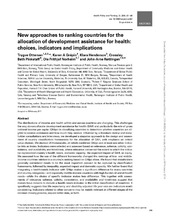| dc.contributor.author | Ottersen, Trygve | en_US |
| dc.contributor.author | Grépin, Karen A. | en_US |
| dc.contributor.author | Henderson, Klara | en_US |
| dc.contributor.author | Pinkstaff, Crossley Beth | en_US |
| dc.contributor.author | Norheim, Ole Frithjof | en_US |
| dc.contributor.author | Røttingen, John-Arne | en_US |
| dc.date.accessioned | 2019-06-20T12:03:02Z | |
| dc.date.available | 2019-06-20T12:03:02Z | |
| dc.date.issued | 2018-02 | |
| dc.Published | Ottersen T, Grépin, Henderson, Pinkstaff, Norheim OF, Røttingen J. New approaches to ranking countries for the allocation of development assistance for health: Choices, indicators and implications. Health Policy and Planning. 2018;33:i31-i46 | eng |
| dc.identifier.issn | 0268-1080 | |
| dc.identifier.issn | 1460-2237 | |
| dc.identifier.uri | https://hdl.handle.net/1956/20288 | |
| dc.description.abstract | The distributions of income and health within and across countries are changing. This challenges the way donors allocate development assistance for health (DAH) and particularly the role of gross national income per capita (GNIpc) in classifying countries to determine whether countries are eligible to receive assistance and how much they receive. Informed by a literature review and stakeholder consultations and interviews, we developed a stepwise approach to the design and assessment of country classification frameworks for the allocation of DAH, with emphasis on critical value choices. We devised 25 frameworks, all which combined GNIpc and at least one other indicator into an index. Indicators were selected and assessed based on relevance, salience, validity, consistency, and availability and timeliness, where relevance concerned the extent to which the indicator represented country’s health needs, domestic capacity, the expected impact of DAH, or equity. We assessed how the use of the different frameworks changed the rankings of low- and middle-income countries relative to a country’s ranking based on GNIpc alone. We found that stakeholders generally considered needs to be the most important concern to be captured by classification frameworks, followed by inequality, expected impact and domestic capacity. We further found that integrating a health-needs indicator with GNIpc makes a significant difference for many countries and country categories—and especially middle-income countries with high burden of unmet health needs—while the choice of specific indicator makes less difference. This together with assessments of relevance, salience, validity, consistency, and availability and timeliness suggest that donors have reasons to include a health-needs indicator in the initial classification of countries. It specifically suggests that life expectancy and disability-adjusted life year rate are indicators worth considering. Indicators related to other concerns may be mainly relevant at different stages of the decision-making process, require better data, or both. | en_US |
| dc.language.iso | eng | eng |
| dc.publisher | Oxford University Press | eng |
| dc.relation.uri | https://academic.oup.com/heapol/article/33/suppl_1/i31/4835242 | |
| dc.rights | Attribution CC BY | eng |
| dc.rights.uri | http://creativecommons.org/licenses/by/4.0 | eng |
| dc.subject | Aid | eng |
| dc.subject | development assistance for health | eng |
| dc.subject | equity | eng |
| dc.subject | health financing | eng |
| dc.title | New approaches to ranking countries for the allocation of development assistance for health: Choices, indicators and implications | en_US |
| dc.type | Peer reviewed | |
| dc.type | Journal article | |
| dc.date.updated | 2019-02-06T09:57:07Z | |
| dc.description.version | publishedVersion | en_US |
| dc.rights.holder | Copyright 2018 The Author(s) | |
| dc.identifier.doi | https://doi.org/10.1093/heapol/czx027 | |
| dc.identifier.cristin | 1588491 | |
| dc.source.journal | Health Policy and Planning | |

